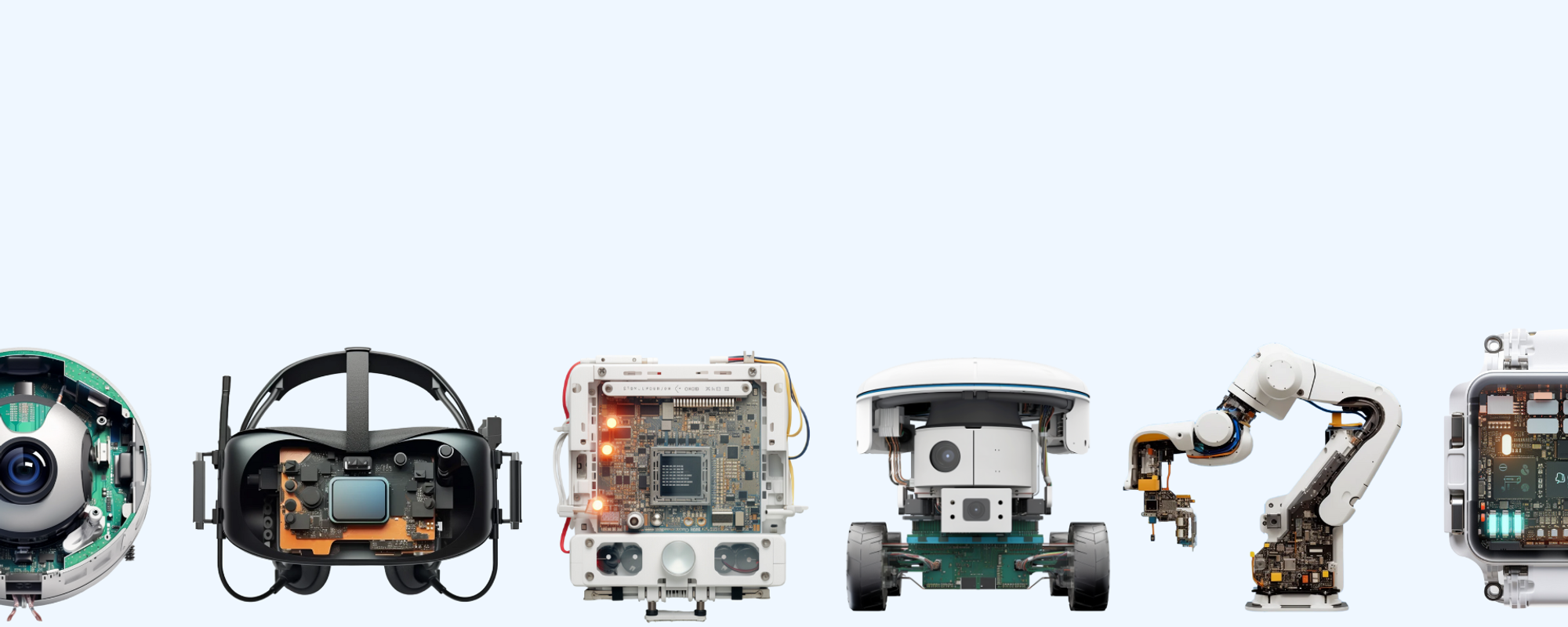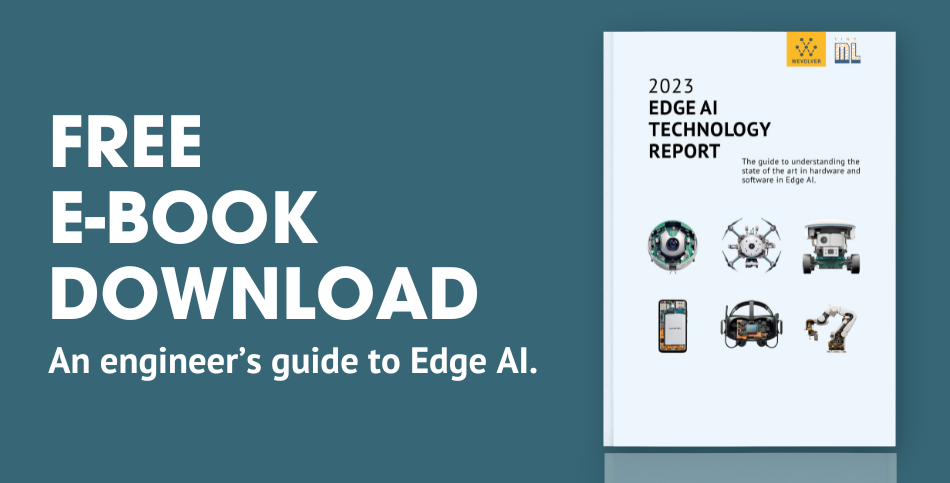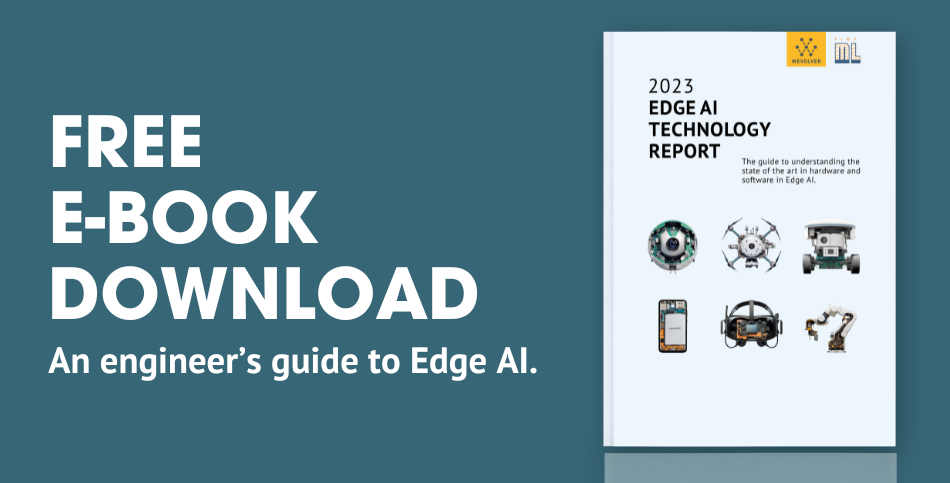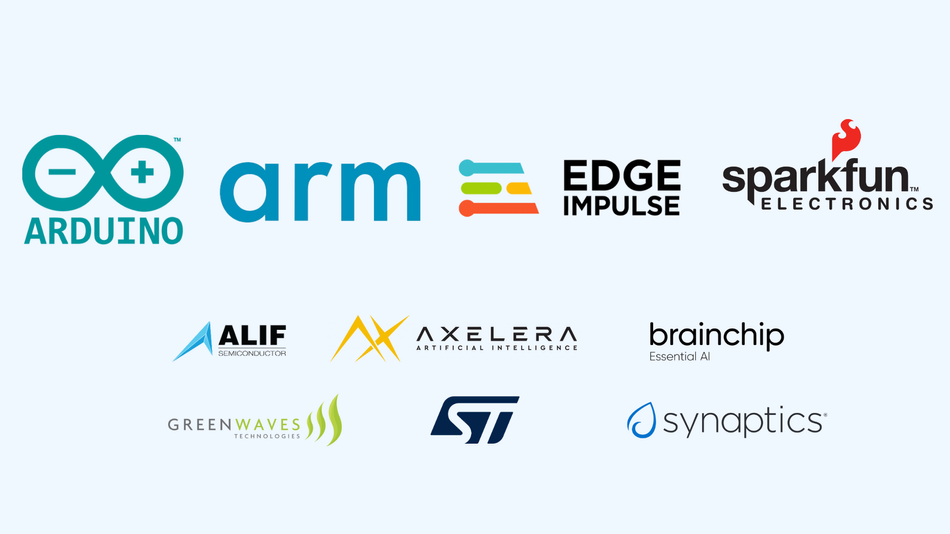2023 Edge AI Technology Report
The guide to understanding the state of the art in hardware & software in Edge AI.

We are thrilled to share the 2024 State of Edge AI Report. This is Wevolver's second in-depth report on Edge AI, building on our 2023 report which focused on the technological foundations. While our previous report explored the technical landscape, this year's edition takes a deeper look at real-world applications and industry-specific implementations.
2023 Edge AI Technology Report.
Edge AI, empowered by the recent advancements in Artificial Intelligence, is driving significant shifts in today's technology landscape. By enabling computation near the data source, Edge AI enhances responsiveness, boosts security and privacy, promotes scalability, enables distributed computing, and improves cost efficiency.
Wevolver has partnered with industry experts, researchers, and tech providers to create a detailed report on the current state of Edge AI. This document covers its technical aspects, applications, challenges, and future trends. It merges practical and technical insights from industry professionals, helping readers understand and navigate the evolving Edge AI landscape.
Report Introduction
The advent of Artificial Intelligence (AI) over recent years has truly revolutionized our industries and personal lives, offering unprecedented opportunities and capabilities. However, while cloud-based processing and cloud AI took off in the past decade, we have come to experience issues such as latency, bandwidth constraints, and security and privacy concerns, to name a few. That is where the emergence of Edge AI became extremely valuable and transformed the AI landscape.
Edge AI represents a paradigm shift in AI deployment, bringing computational power closer to the data source. It allows for on-device data processing and enables real-time, context-aware decision-making. Instead of relying on cloud-based processing, Edge AI utilizes edge devices such as sensors, cameras, smartphones, and other compact devices to perform AI computations on the device itself. Such an approach offers multitudes of advantages, including reduced latency, improved bandwidth efficiency, enhanced data privacy, and increased reliability in scenarios with limited or intermittent connectivity.
“Even with ubiquitous 5G, connectivity to the cloud isn’t guaranteed, and bandwidth isn’t assured in every case. The move to AIoT increasingly needs that intelligence and computational power at the edge.”
- Nandan Nayampally, CMO, Brainchip
While Cloud AI predominantly performs data processing and analysis in remote servers, Edge AI focuses on enabling AI capabilities directly on the devices. The key distinction here lies in the processing location and the nature of the data being processed. Cloud AI is suitable for processing-intensive applications that can tolerate latency, while Edge AI excels in time-sensitive scenarios where real-time processing is essential. By deploying AI models directly on edge devices, Edge AI minimizes the reliance on cloud connectivity, enabling localized decision-making and response.
The Edge encompasses the entire spectrum from data centers to IoT endpoints. This includes the data center edge, network edge, embedded edge, and on-prem edge, each with its own use cases. The compute requirements essentially determine where a particular application falls on the spectrum, ranging from data-center edge solutions to small sensors embedded in devices like automobile tires. Vibration-related applications would be positioned towards one end of the spectrum, often implemented on microcontrollers, while more complex video analysis tasks might be closer to the other end, sometimes on more powerful microprocessors.
“Applications are gradually moving towards the edge as these edge platforms enhance their compute power.”
- Ian Bratt, Fellow and Senior Director of Technology, Arm
When it comes to Edge AI, the focus is primarily on sensing systems. This includes camera-based systems, audio sensors, and applications like traffic monitoring in smart cities. Edge AI essentially functions as an extensive sensory system, continuously monitoring and interpreting events in the world. In an integrated-technology approach, the collected information can then be sent to the cloud for further processing.
Edge AI shines in applications where rapid decision-making and immediate response to time-sensitive data are required. For instance, in autonomous driving, Edge AI empowers vehicles to process sensor data onboard and make split-second decisions to ensure safe navigation. Similarly, in healthcare, Edge AI enables real-time patient monitoring, detecting anomalies, and facilitating immediate interventions. The ability to process and analyze data locally empowers healthcare professionals to deliver timely and life-saving interventions.
Edge AI application areas can be distinguished based on specific requirements such as power sensitivity, size limitations, weight constraints, and heat dissipation. Power sensitivity is a crucial consideration, as edge devices are often low-power devices used in smartphones, wearables, or Internet of Things (IoT) systems. AI models deployed on these devices must be optimized for efficient power consumption to preserve battery life and prolong operational duration.
Size limitations and weight constraints also play quite a significant role in distinguishing Edge AI application areas. Edge devices are typically compact and portable, making it essential for AI models to be lightweight and space-efficient. This consideration is particularly relevant upon integrating edge devices into drones, robotics, or wearable devices, where size and weight directly impact performance and usability.
Nevertheless, edge computing presents significant advantages that weren’t achievable beforehand. Owning the data, for instance, provides a high level of security, as there is no need for the data to be sent to the cloud, thus mitigating the increasing cybersecurity risks. Edge computing also reduces latency and power usage due to less communication back and forth with the cloud, which is particularly important for constrained devices running on low power. And the advantages don’t stop there, as we are seeing more and more interesting developments in real-time performance and decision-making, improved privacy control, and on-device learning, enabling intelligent devices to operate autonomously and adaptively without relying on constant cloud interaction.
“The recent surge in AI has been fueled by a harmonious interplay between cutting-edge algorithms and advanced hardware. As we move forward, the symbiosis of these two elements will become even more crucial, particularly for Edge AI.”
- Dr. Bram Verhoef, Head of Machine Learning at Axelera AI
Edge AI holds immense significance in the current and future technology landscape. With decentralized AI processing, improved responsiveness, enhanced privacy and security, cost-efficiency, scalability, and distributed computing, Edge AI is revolutionizing our world as we speak. And with the rapid developments happening constantly, it may be difficult to follow all the new advancements in the field.
That is why Wevolver has collaborated with several industry experts, researchers, professors, and leading companies to create a comprehensive report on the current state of Edge AI, exploring its history, cutting-edge applications, and future developments. This report will provide you with practical and technical knowledge to help you understand and navigate the evolving landscape of Edge AI.
This report would not have been possible without the esteemed contributions and sponsorship of Alif Semiconductor, Arduino, Arm, Axelera AI, BrainChip, Edge Impulse, GreenWaves Technologies, Sparkfun, ST, and Synaptics. Their commitment to objectively sharing knowledge and insights to help inspire innovation and technological evolution aligns perfectly with what Wevolver does and the impact it aims to achieve.
As the world becomes increasingly connected and data-driven, Edge AI is emerging as a vital technology at the core of this transformation, and we hope this comprehensive report provides all the knowledge and inspiration you need to participate in this technological journey.
Samir Jaber
Editor-in-Chief
This text was contributed to by engineers from Arm, Axelera AI, and BrainChip.
The 2023 Edge AI Technology Report
The guide to understanding the state of the art in hardware & software in Edge AI.
Click through to read each of the report's chapters.
Chapter I: Overview of Industries and Application Use Cases
Chapter II: Advantages of Edge AI
Chapter III: Edge AI Platforms
Chapter IV: Hardware and Software Selection
Chapter V: Tiny ML
Chapter VI: Edge AI Algorithms
Chapter VII: Sensing Modalities
Chapter VIII: Case Studies
Chapter IX: Challenges of Edge AI
Chapter X: The Future of Edge AI and Conclusion
How this report came to be: A collaborative effort
This report is the culmination of collaborative efforts among a diverse team of contributors. Initial input was graciously provided by our sponsors and partner, who shared their expert opinions and insightful case studies, creating a strong technical foundation. A dedicated team of writers further expanded these texts under the careful guidance of our Editor-in-Chief. Thank you to our report sponsors and report partner, the tinyML Foundation.
About the writers
Samir Jaber, Editor-in-chief.
Samir Jaber is an SEO & Content Specialist with a background in engineering, nanotechnology, and scientific research. Samir has comprehensive experience working with major engineering and technology companies as a writer, editor, and digital marketing consultant. He is an expert in content management and strategy, particularly in the engineering and tech fields. He is a featured author in 30+ industrial magazines with a focus on IoT, nanotechnology, materials science, engineering, and sustainability. Samir is also an award-winning engineering researcher in the fields of nanofabrication and microfluidics.
Dr. John Soldatos
John Soldatos holds a Ph.D. in Electrical & Computer Engineering from the National Technical University of Athens (2000) and is currently an Honorary Research Fellow at the University of Glasgow, UK (2014-present). He was Associate Professor and Head of the Internet of Things (IoT) Group at the Athens Information Technology (AIT), Greece (2006–2019), and Adjunct Professor at the Carnegie Mellon University, Pittsburgh, PA (2007–2010). He has significant experience working closely with large multi-national industries (e.g., IBM, INTRACOM, INTRASOFT International) as an R&D consultant and delivery specialist while being a scientific advisor to various high-tech startup enterprises. Dr. Soldatos is an expert in Internet-of-Things (IoT) and Artificial Intelligence (AI) technologies and applications, including IoT/AI applications in smart cities, finance (Finance 4.0), and industry (Industry 4.0).
Dr. Miroslav Milovanovic
Miroslav Milovanovic has a Ph.D. in Computer Science and Electrotechnics and works as an assistant professor at the Faculty of Electronic Engineering. He teaches courses strongly connected with Data Science, the Industrial Internet of Things, Modern Control of Industrial Processes, and Intelligent control.
Additionally, Dr. Milovanovic is the Chief of the Laboratory for Intelligent Control in the Control Systems Department. His instructional expertise encompasses courses strongly connected with Data Science, the Industrial Internet of Things, Deep Learning, Machine Learning in Python, Modern Control of Industrial Processes, and Intelligent Control. By imparting practical knowledge in these areas, he empowers students to excel in their chosen fields. With over 45 published scientific papers, his research primarily revolves around Data Science, Deep Learning, and their practical applications.
Lydia Husser
Lydia Husser is a technical writer in robotics and a freelance writer captivated by innovative science and engineering. She holds a degree in Computer Science and credentials in electronics technology. Her background includes work in robotics, communications hardware, and developer documentation.
The cover image of the report was created using generative AI tools. Credit to Muthali Ganesh.


